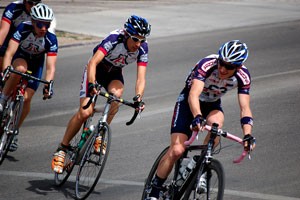Senior Brian Mayer found out about the UA Cycling Club at a party. He noticed Melanie Meyers, now treasurer of the club, had the same kind of Italian bicycle and they started talking.
“”There are so many types of bicycles. It’d be like if someone had a unique car, you might start talking to them,”” Mayer said. “”You spend a lot of time with a bike so you develop a lot of affection for the bike you ride.””
That may not be your conventional icebreaker, but the UA Cycling Club is about community. Meyers pointed Mayer toward the team and now he is in his third season racing. Not bad for a conversation starter.
The UA Cycling Club brings together a mix of cycling enthusiasts. Meyers, along with team president Chloe Forsman, have raced professionally while cyclists, like Mayer, consider themselves amateurs.
It’s a cycling family. The team not only competes in and hosts cycling races, but also meets for dinner or movie nights. Once a semester the team holds a “”Bike Fix-It”” day on campus to help students with their bicycles.
“”I think networking is key,”” Forsman said.
Several members admitted collegiate cycling, especially in the Southwestern Collegiate Cycling Conference, remains a small affair. Mechanical engineering doctoral student Kyle Colavito estimated a collegiate race often sees about 10 entrants. Many UA cyclists do their riding outside of the club with other teams in addition to racing for their school. Mayer estimated collegiate racing represents only about 10 percent of the races club members were involved in. Still, club members said racing for the UA was an important supplement to their cycling life. The club gives students a chance to represent not only themselves, but also their school. For others, the club is a gateway to the sport.
“”It’s where I got my start,”” said Colavito, who now races for both the UA and local team, RideClean. “”A lot of my best friends are on the collegiate team. It’s the team aspect. It’s fun to share your knowledge with new riders.””
Before he joined the team, Colavito said he had never raced competitively.
“”This is the team I’ve managed to stay on longest,”” said Meyers, who also races for Specialized Designs for Women. “”Collegiate racing is a totally different atmosphere and a fun one.””
UA cycling is not just a fun way to ride a bike and wear red and blue. Meyers said that at the national championships, cycling events are almost as difficult as a pro race.
“”For a lot of us who don’t compete professionally, the national races are the hardest,”” Mayer added.
Competing at the top levels means club members treat their bicycles like a part-time job. Members often log between 15 to 20 hours a week.
Meyers said she typically rides six days a week, trains four days during the week and participates in one or two races on the weekends. She said it takes that much time to stay competitive.
Mayer agreed that the time commitment is challenging, especially to college students used to a nocturnal lifestyle.
“”Racing hard is one thing, but waking up every morning (to ride) and balancing that with school is, I think for me, the most challenging thing,”” Mayer added. “”You’re telling your significant other that you have to go to bed at 9 o’clock because you have to wake up and ride.””
So UA cycling isn’t just a leisurely ride around the UA Mall, even if the weather makes Tucson a winter paradise for cyclists.
“”It’s always hard. It’s never easy,”” Colavito said. “”There can be 50 to 100 guys in a race and one guy wins.””
Graduate student Kathy Rakel, who spends about 10 hours a week on her bicycle – and also trains for triathlons – said cycling can sometimes be downright painful.
“”You’re on a saddle for hours, sometimes that’s bad,”” she said.
Still, Rakel said she actually likes “”the challenge and pain that comes from riding your bike, racing, staying in the pack.””
She likes pain?
“”I know that sounds really weird,”” she said. “”It can be painful when you’re trying really hard. It’s not the pain I love, it’s the feeling of finishing that’s really rewarding. After the race it’s, ‘Wow, I did that?’ Knowing that makes it even better.””









